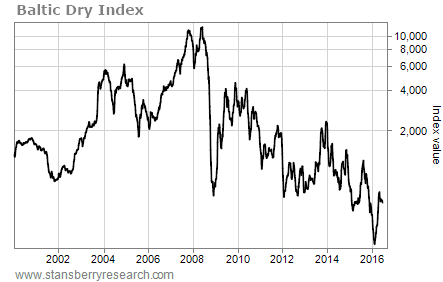One of the seven wonders of the modern world just received a massive facelift.
And it could be the first sign for investors that one of the world’s most left-for-dead industries is ready for a turnaround.
[ad#Google Adsense 336×280-IA]The Panama Canal – a 48-mile-long man-made waterway that connects the Atlantic and Pacific oceans – saves vessels from having to travel around Cape Horn at the bottom tip of South America.
This knocks 8,000 miles – and a lot of expenses – off the journey.
But the canal initially opened more than 100 years ago. It hasn’t been wide enough or deep enough for some of today’s largest ships, like the New Panamax vessels… until now.
Thanks to a multibillion-dollar expansion project, the Panama Canal now has a third lane of locks… as well as wider and much deeper channels. This will allow larger volumes of U.S. crude oil and natural gas to head to Asia from the East Coast and the Gulf of Mexico.
The new route will cut two weeks of travel time for bigger ships heading to Asia compared with the trip around the Cape of Good Hope in South Africa. And it’s 11 days shorter than a trip through the Suez Canal in Egypt.
Shorter travel time means lower costs for everyone. And that’s a needed development for an industry that has been beaten down in recent years.
You see, the shipping industry is a notoriously cyclical business. The costs of moving goods on the sea go up and down as regularly as the prices of the goods that these ships deliver.
In 2007, when the expansion project began, the sector sat near the height of its most recent peak. That’s no longer the case today, though. We’re eight years into one of the worst shipping-industry bear markets in history.
Since it’s a cyclical business – and with the recent Panama Canal expansion cutting down costs – the sector could be setting up an opportunity for us to make some huge gains…
Let’s look at the Baltic Dry Index (“BDI”). The BDI is an estimate of the price of moving commodities like coal, iron ore, and grain by ship. It takes 23 shipping routes into account, including the Panama Canal.
The BDI gives us a glimpse into the market for ships. When the index is high – as it was back in 2007 – that means demand is high relative to the supply of available ships. But when the index is low – as it is today – there are plenty of ships… and not enough cargo to fill them.

As you would expect, this is also showing up in the share prices of shipping companies.

Eagle Bulk Shipping (EGLE) is a classic example of what a bear market can do. The company declared bankruptcy in August 2014, restructured, and began doing business again later that year.
On October 16, 2014, the new company emerged from bankruptcy with shares trading at $15.80. They hit $16.44 later that month. However, the lack of demand for shipping wore the company down. Today, its shares trade for around $0.50 each. That’s a 97% decline in 20 months.
The trend is so bad that it could send more companies into bankruptcy. The problem is demand for goods. The same forces that sent the prices of iron ore, coal, and oil plummeting are also acting on the shipping industry. Demand is down. The only solution to that problem in this cyclical business is time.
When it’s time to put our money to work in the shipping industry, we can buy shares of one of the companies listed above. But there’s an even easier way to get involved – the Guggenheim Shipping Fund (SEA). This exchange-traded fund allows us to invest in the sector… without taking on the risk of individual companies.
We’ll keep an eye on this story. These stocks could provide investors with huge profits once the trend reverses and the demand for ships increases again.
Good investing,
Matt Badiali
[ad#stansberry-ps]
Source: Growth Stock Wire
